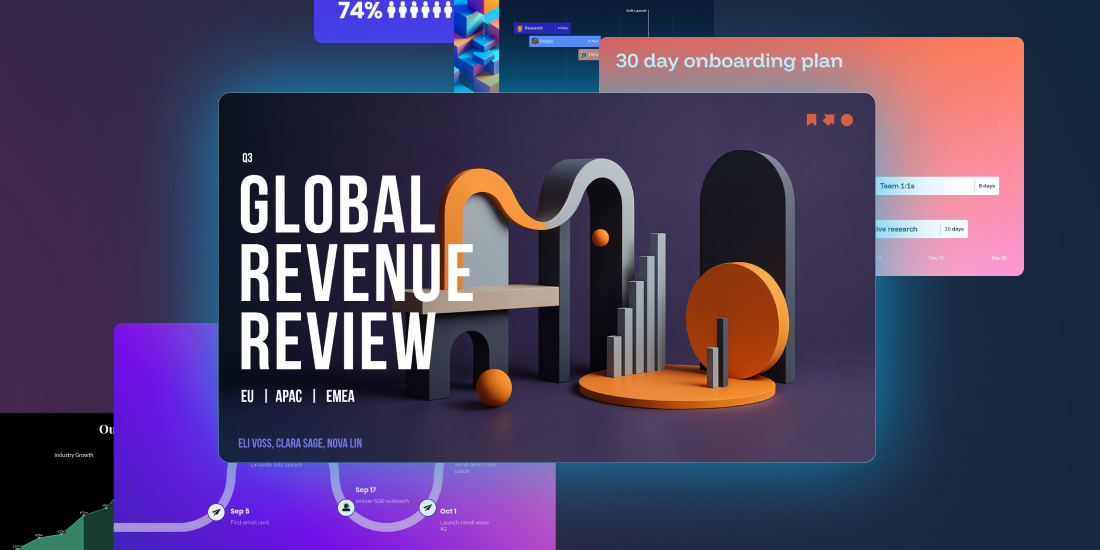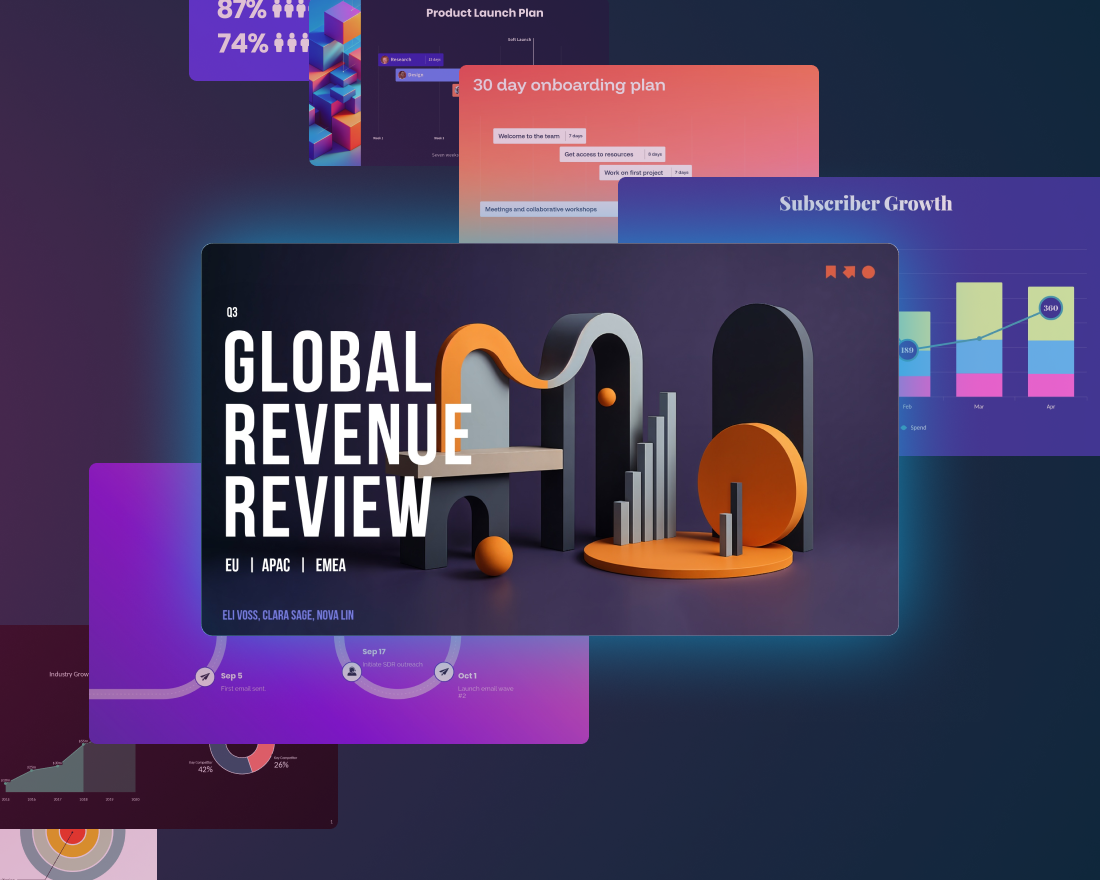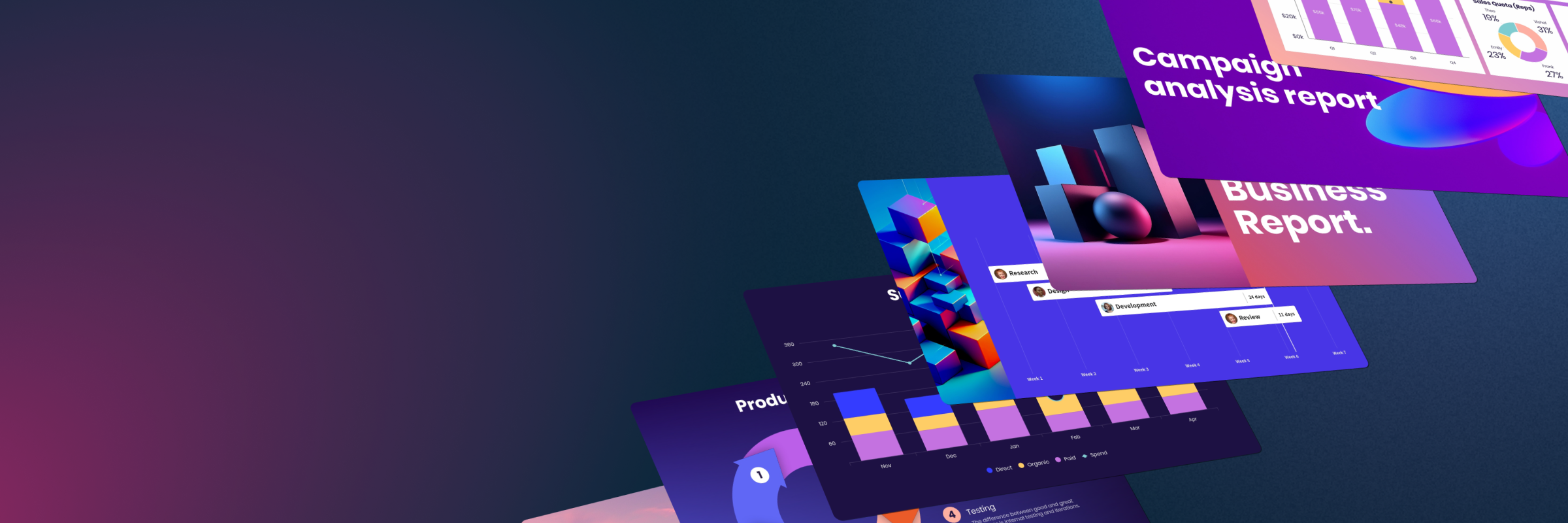
The presentation isn’t dead—but the old way of building them is.
If you’ve ever wondered whether slide decks are still relevant in today’s modern workplace where video is king, the answer is yes. But the role of presentations has shifted. In 2025, business decks are more than visual aids to tired speeches; they’re creative vehicles for storytelling, persuasion, and collaboration. Whether you’re delivering a sales pitch, reporting to the board, or aligning cross-functional teams, expectations for clarity and quality are higher than ever. New standards, tools, and audience behaviors are shaping what makes a presentation truly effective. This is especially important for business presentations.
6 Things that make a great business presentation in 2025
In a competitive business landscape, having a great presentation can be the difference between a company that grows and one that leaves money on the table. Here are six things to consider as you build out your next business deck.
1. Story first, slides second
The foundation of any great presentation is its story. Audiences crave clarity and connection, not clutter. The best decks follow a clear narrative arc to keep audiences engaged: problem, insight, solution, impact. Instead of overwhelming stakeholders with dozens of slides, effective presenters focus on a structure that guides the audience smoothly from challenge to resolution.
Pro tip: Using pre-built templates reinforce narrative flow, and encourage you to structure your story in new ways that prioritize the most important information.
2. Good design is no longer optional
In 2025, good design isn’t a “nice-to-have”—it’s an expectation. Executives and stakeholders now assume every deck, even for internal use, will look professional and on-brand. Why? Because consistency signals reliability and builds trust. Fortunately, design no longer acts as a bottleneck. Modern presentation tools, like Beautiful.ai, have leveled the playing field. Now anyone on the team has the ability to produce slides that look like they were crafted by a design team.
Pro tip: Leverage Beautiful.ai’s Smart Slide templates to nail presentation design. The templates use the principles of good design as their north star and automatically adapt as you add in your content, ensuring your slides are professional and on-brand.
3. Data that moves (literally and figuratively)
Gone are the days of static, hard-to-read charts. Today’s audiences expect data storytelling that is both dynamic and digestible. Animated graphs, clean visuals, and real-time integrations turn raw numbers into insights that resonate. Whether you’re sharing quarterly results or customer trends, the ability to present complex data into bite-size chunks helps your message land better with the audience.
Pro tip: Subtle animations can help direct the audience to the most important metrics on the screen, while keeping them engaged. Not only does this make it more digestible, but they’re more likely to retain the information after the fact.
4. AI as a creative partner
Artificial intelligence has shifted from being a novelty to an everyday collaborator. In 2025, AI helps professionals brainstorm slide ideas, refine copy, adjust tone, and summarize insights. This not only saves time but also elevates the quality of work for teams who may not consider themselves writers or designers. If you’re feeling stuck on your next business presentation, let AI act as your sounding board.
Pro tip: Beautiful.ai’s AI assistant is great for refining text, suggesting slide layouts based on your content, generating images for your story, or crafting speaker notes for your pitch.
5. Collaborative and in the cloud
Business doesn’t happen in static meeting rooms anymore—it happens across time zones, devices, and platforms. That means your presentation should always be ready to go, no matter where or when you need it. Cloud-based decks with real-time editing, async commenting, and auto-save features make presentation design more seamless for teams that move fast. They eliminate version-control nightmares and last-minute formatting scrambles, ensuring teams can focus on the content that matters.
Pro tip: When you collaborate in Beautiful.ai, everyone is always working in the most recent version of the deck. This means data and information is up to date and ready for any meeting, virtual or in-person, at any time.
6. Personalization at scale
One-size-fits-all presentations are a relic of the past. Audiences expect content tailored to their needs, whether you’re pitching a prospect, onboarding a new hire, or updating your operations team. The challenge? Delivering personalization without reinventing the wheel every time. Scalable templates, modular content, and shared content libraries make it possible to localize and personalize messaging while maintaining consistency.
Pro tip: Use reusable slides and slide-level editing to quickly adapt content for different teams, markets, or client conversations.
The bar is higher, but the tools are smarter
The future of business presentations is here, and it’s demanding. Audiences in 2025 expect clarity, quality design, dynamic data, and personalized messaging—all delivered seamlessly across devices and workflows. But while the bar is higher than ever, the tools at your disposal are smarter than ever, too.
With platforms like Beautiful.ai, every professional—not just designers—can create decks that inform, inspire, and drive action. By pairing thoughtful storytelling with automated design and AI-driven support, your team can stay ahead of the curve and deliver business presentations that truly land.




.gif)
.png)
